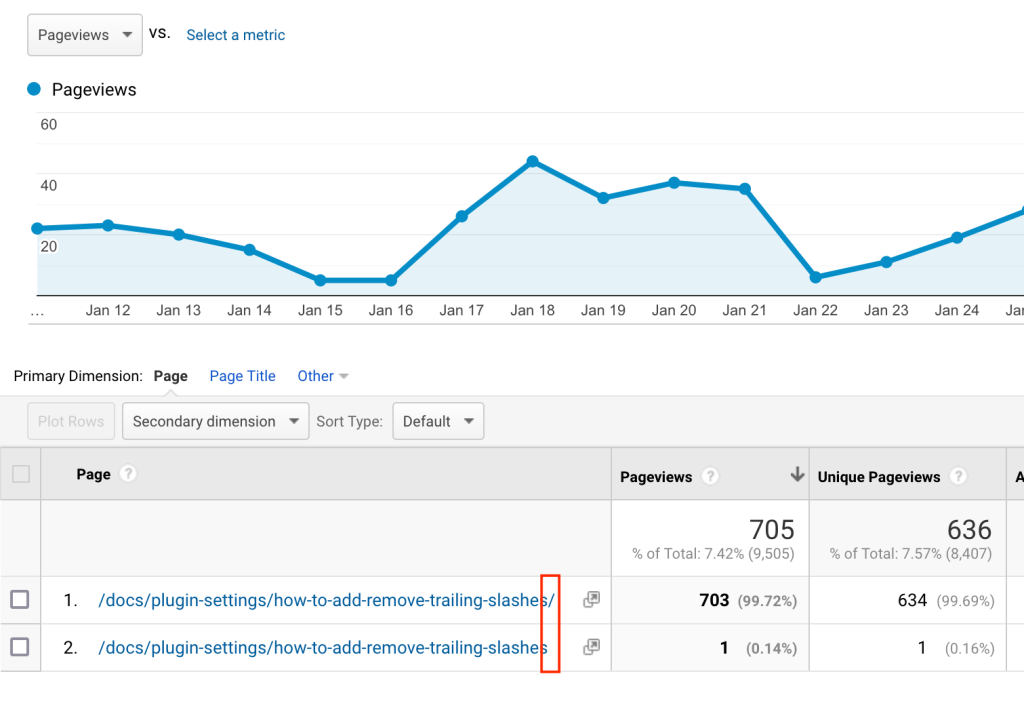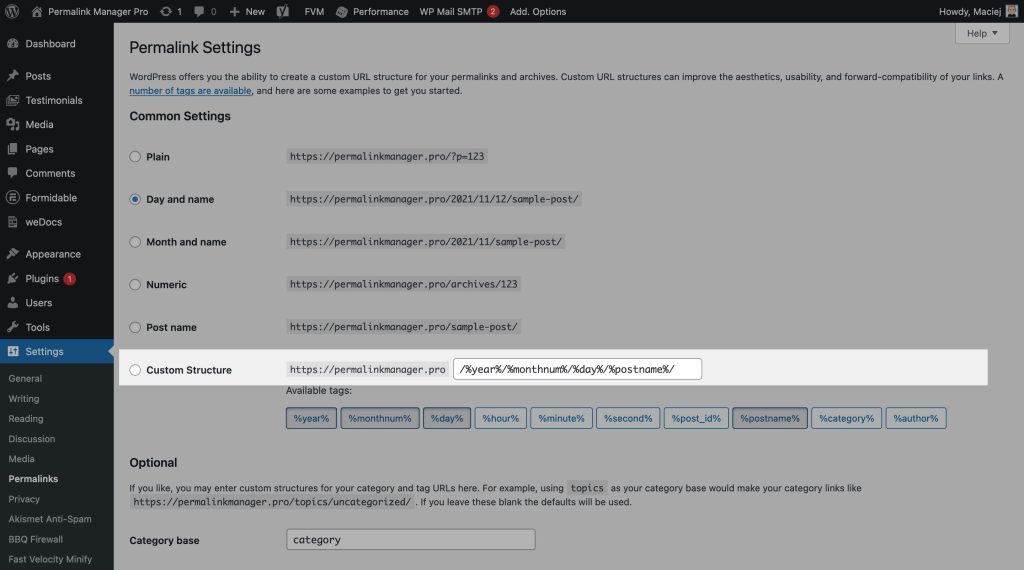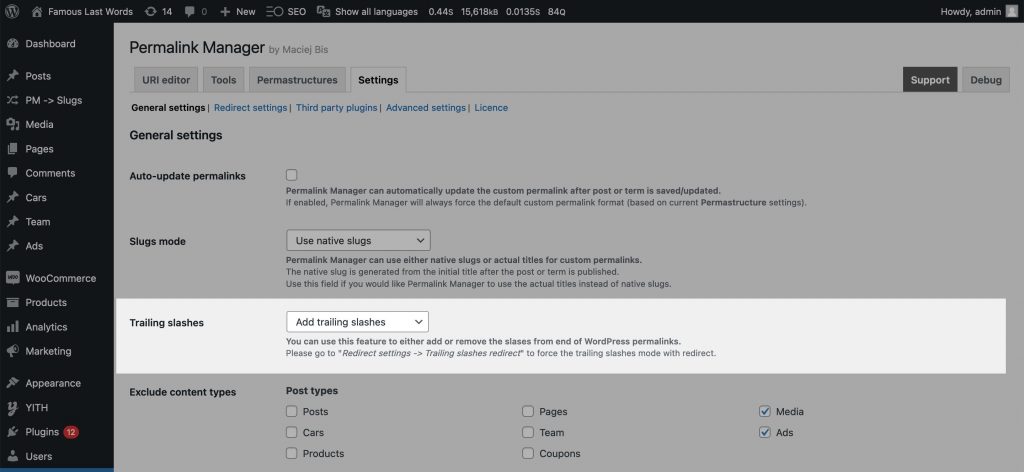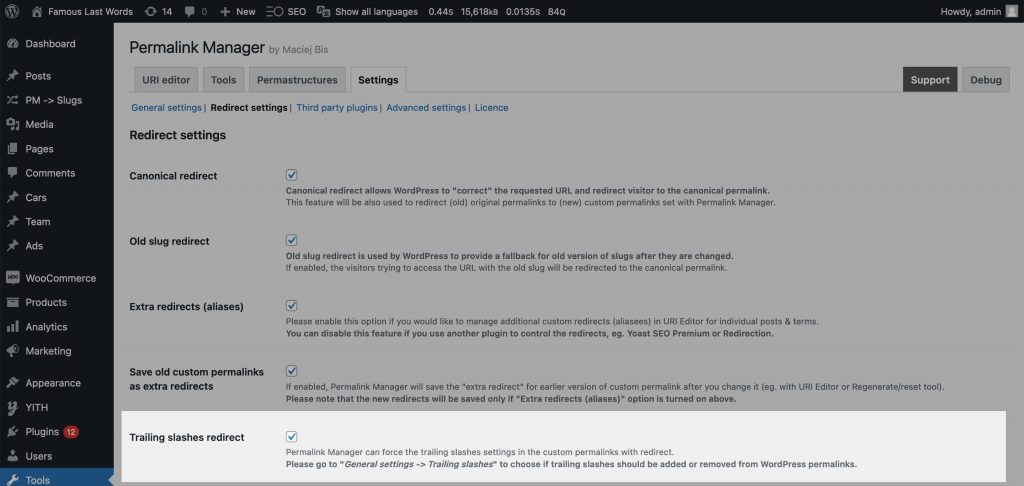The trailing slash is often neglected, but when not configured correctly, it can cause duplicate content issues that may harm SEO and website's crawlability.
Simply speaking, trailing slashes refer to the forward slash at the end of URLs. Many WordPress site owners do not know how to control whether or not they are added to the permalinks.
Unfortunately, the admin dashboard does not clearly indicate how they can be adjusted, though they depend on the selected permalink structure.
In this article, you will learn how to access these settings and the SEO risks of ignoring them. You will also find out how to enforce a chosen URL version with WordPress redirects or server configuration files.
What Are the Trailing Slashes?
Generally speaking, slashes in URLs are used to distinguish between files and directories/folders. Separating directories and subdirectories in a URL allows for hierarchical content organization.

For example, a URL like the one presented above uses slashes to show the product is located in the "products" folder, which is inside the "olive" and "greece" subfolders.
The forward slash (highlighted in red) at the end of a website address is called a trailing slash. By design, URLs for folders or directories are meant to end with a slash. This helps distinguish them from single file URLs like images, which typically end with a file extension like .jpg or .css instead of a slash.
However, CMS such as WordPress can dynamically change URLs on the fly. So this rule about trailing slashes is not always followed as strictly as it used to be. The CMS might add or remove that slash depending on what helps people find the page more easily. So both folder URLs with a trailing slash and single file URLs without one can work fine nowadays.
Does Trailing Slash Matter for SEO?
Considering the possible effect on SEO that trailing slashes in WordPress permalinks might have, it is surprising how little information there is on the subject.
Happily, there is nothing complicated or hard to understand here. Depending on the permalinks settings, trailing slashes may be automatically appended or removed from all URL addresses.
Take a close look at these URLs below. Both look identical, but only at first glance. The first URL varies from the second in that it finishes with a slash.

Most visitors to your website likely will not notice whether URLs include a trailing slash or not. It might, however, make a significant difference for search engine crawlers. Search bots may consider the second variant of URL as a duplicate if they can reach the same page via separate URLs.
Duplicate URLs complicate the crawling process and can make it harder for search engines like Google to determine the correct URL to index. If your URLs can be accessed both with and without a trailing slash, it may lead to inefficient use of your crawl budget.
To put it simply, search engine crawlers need to visit each URL variant, effectively doubling the crawl resources used for a single piece of content.
Cache Plugins Issues
To minimize server resource usage, cache plugins (e.g. WP Rocket) store only one version of a URL, either with or without trailing slashes. As a result, PHP-based redirects, such as the built-in canonical redirect in WordPress or the Permalink Manager trailing slash functions, may fail.
Because of the script cache, the aforementioned functions will not be able to detect whether the URL ends with a slash or not.
If the PHP-based trailing slash redirect isn’t working due to cache plugin, you can configure the server to process the redirect earlier, before PHP runs. The next sections of this article include additional tips on how to accomplish this.
Google Analytics Reports and Trailing Slashes Inconsistency
In addition, if your website handles trailing slashes inconsistently, it is possible that duplicate URLs may appear in your Google Analytics results. While past statistics cannot be fixed, you can adjust the future collection of data to avoid this issue.

Thankfully, it can be avoided with a straightforward fix. The first option is to apply the URL filters that are included into Google Analytics. There are numerous articles, such as this one, that explain how to use them.
However, forcing one version of the URL via a "301" redirect directly on your server is the most reliable and recommended method. You may accomplish this by adjusting server configuration or by using a third-party plugin like Permalink Manager.
How WordPress Manages Trailing Slashes in URLs?
Controlling whether URLs have a trailing slash or not does not usually require any extra plugins. WordPress manages this through the "Custom Structure" field in the Permalink Settings.

To change it, go to "Settings -> Permalinks" and adjust the field:
- Add trailing slashes
To include trailing slashes in URLs, add a slash at the end.
Because the structure field ends in a slash (see red arrow), the trailing slashes will be automatically added to all URLs. - Remove trailing slashes
Remove the slash at the end if you prefer URLs without trailing slashes.
To remove the trailing slash from WordPress permalinks, simply make sure the structure does not end with a slash.
Regardless of whether you decide to include trailing slashes in the URLs or not, you need make sure that only one version is available in order to avoid the "duplicated content" SEO issue. Redirecting non-trailing slash URLs to trailing slash URLs or vice versa is an effective way to prevent it.
Canonical URLs are handled by WordPress to some extent with the canonical redirect, however this functionality may be affected by factors such as server configuration, caching, and 3rd party plugins.
Handling Trailing Slash Redirects with Server Configuration
Apache Servers
If you are using Apache server, you can try to address this issue by adding extra code snippet at the top of your .htaccess file in the main directory where WordPress is installed.
#
# A. Remove trailing slashes
#
RewriteEngine on
RewriteCond %{REQUEST_FILENAME} !-d
RewriteRule ^(.*)/$ /$1 [L,R=301]
#
# B. Force trailing slashes
#
RewriteEngine on
# Exclude files and directories under "wp-content", "wp-admin", "wp-json" and URLs with query parameters
RewriteCond %{REQUEST_URI} !^/?wp-(admin|json|content)
RewriteCond %{QUERY_STRING} ^$
# This rule should not be applied to URLs that look like filenames and already end with a trailing slash
RewriteCond %{REQUEST_URI} !(\.[a-zA-Z0-9]{1,5}|/)$
# Check if the request URI does not end with a slash
RewriteCond %{REQUEST_URI} !(.+)/$
# If all conditions are met, redirect to the same URI with a trailing slash
RewriteRule (.*) %{REQUEST_URI}/ [R=301,L]NGINX Servers
While Apache allows easy modifications through .htaccess files, NGINX configuration is more complicated and often requires direct server access which might not be available on many hosting platforms.
In order to use the below snippet, you will need access to the NGINX configuration files on your server and know how to edit server blocks.
#
# A. Remove trailing slashes
# Place this inside server {} block
#
location / {
# Don't remove slash from real directories
if (!-d $request_filename) {
# Remove trailing slash
rewrite ^/(.*)/$ /$1 permanent;
}
}
#
# B. Force trailing slashes
# Place this inside server {} block
#
location / {
# Exclude WordPress admin, API, and content directories
if ($request_uri !~ "^/?wp-(admin|json|content)") {
# Exclude URLs with query parameters
if ($args = "") {
# Exclude files with extensions and URLs already ending with slash
if ($request_uri !~ "\.[a-zA-Z0-9]{1,5}$") {
if ($request_uri !~ "/$") {
rewrite ^(.*)$ $1/ permanent;
}
}
}
}
}Permalink Manager Settings
By default, Permalink Manager uses the native trailing slash settings, but you can adjust them in the plugin settings if needed. There is also an option to enable a trailing slash redirect, which improves the native canonical redirect.
"Trailing slashes" Mode
The plugin dynamically filters $wp rewrite->use_trailing_slashes property, therefore all WordPress permalinks (not only the ones filtered with Permalink Manager) will be affected. Of course, this also applies to meta tags (canonical URLs) and sitemaps built by third-party tools like Yoast SEO or RankMath.

"Trailing slashes redirect"
A canonical redirect is the quickest solution to address duplicate content issues caused by trailing slashes. If you choose to implement the 301 redirect, both users and search engine crawlers will always be sent to to one of two URL versions: with or without slashes.
If you do not know how to code, Permalink Manager may help you in using the redirect. To make it work and force your chosen slashes configuration, enable the "Trailing slashes redirect" option in the plugin settings.
